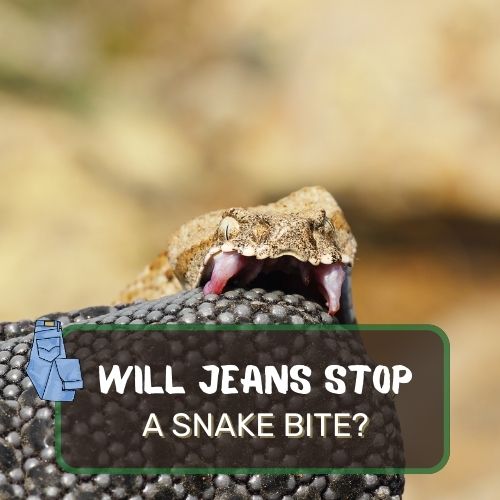
It’s a question many outdoor enthusiasts and adventurers have pondered.
In this article, we delve deep into the relationship between denim and snake bites, exploring the science, myths, and real-world implications.
Drawing from comprehensive studies and real-life encounters, we’ll uncover the protective potential of jeans and the factors influencing their efficacy.
By the end of this read, you’ll gain a clear understanding of denim’s role in snake bite scenarios and be better equipped to navigate snake-prone areas.
Whether you’re a hiker, camper, or just curious, this article promises insights that might just change the way you view your favorite pair of jeans.
Table of Contents
- 1 Will jeans stop a snake bite? (Short Answer)
- 2 Brief history of denim and its use in outdoor activities
- 3 Denim’s potential protective properties against snake bites
- 4 The Science Behind Denim Protection
- 5 The Reality of Snake Bites
- 6 Practical Implications
- 7 Snake Bites Around the World
- 8 Conclusion
- 9 FAQ
Will jeans stop a snake bite? (Short Answer)
Jeans can offer a significant degree of protection against snake bites. Studies have shown that denim can reduce the amount of venom delivered during a bite, especially from rapid defensive strikes. However, while jeans can decrease the risk of severe envenomation, they are not a foolproof barrier. Some snakes, especially larger ones with longer fangs, might still penetrate the fabric. So, while wearing jeans in snake-prone areas can be beneficial, it’s essential to remain cautious and aware of one’s surroundings. In essence, jeans can help, but they don’t guarantee complete protection against snake bites.
Brief history of denim and its use in outdoor activities

Denim, a rugged cotton twill textile, has been a staple in our wardrobes for over a century. Originating in the French town of Nîmes, denim quickly became the go-to material for durable workwear.
Picture gold miners in the 1870s, sifting through rocks and dirt, their jeans bearing the brunt of their laborious tasks. Fast forward to the 1950s, and jeans were no longer just for workers.
They became a symbol of rebellion for teenagers, with icons like James Dean popularizing them in movies.
Over the years, denim transitioned from workwear to everyday wear, and by the 1980s and 1990s, designer jeans had become a fashion statement.
But beyond the fashion world, denim maintained its reputation for durability. Adventurers and outdoor enthusiasts often chose jeans for hikes, camping trips, and other activities, valuing their resilience against wear and tear.
Denim’s potential protective properties against snake bites

Now, let’s address the burning question: “Will jeans stop a snake bite?” Imagine you’re on a hiking trail, surrounded by nature’s beauty, and suddenly, a snake slithers out, ready to strike. Would your trusty pair of jeans offer any protection?
Recent studies have delved into this very question. One such study used southern Pacific rattlesnakes to bite latex gloves, either uncovered or covered with standard denim cloth. The results?
A significant reduction in venom for both small and large snakes when denim was involved. In fact, there was a 60% venom reduction for small snakes and a 66% reduction for larger ones.
But why does denim seem to offer this protection? It’s not just about the material’s thickness. Defensive snake strikes are incredibly fast, often less than 0.33 seconds.
The reduction in venom might be attributed to simple physics and the way the material interacts with the snake’s fangs.
However, it’s essential to note that while denim can reduce the amount of venom, it doesn’t guarantee complete protection. Especially with larger snakes, the venom amount, even after a reduction, can still be lethal.
Let’s take a real-life example. Sarah, an avid hiker, once shared her encounter with a rattlesnake during a trail in Texas.
Wearing her favorite pair of jeans, she felt a sharp sting on her leg. Thankfully, she was near a ranger station, and they confirmed it was a snake bite. While her jeans might have reduced the venom’s impact, she still needed medical attention.
This story underscores the importance of not solely relying on denim for protection but also being aware of one’s surroundings and seeking immediate help if bitten.
In conclusion, while our beloved jeans might offer some level of protection against snake bites, they’re not a foolproof shield. It’s always best to tread with caution, especially in snake-prone areas.
And if you ever find yourself in a snake encounter, remember Sarah’s story and seek medical attention immediately.
The Science Behind Denim Protection

When it comes to understanding the protective properties of denim against snake bites, it’s crucial to dive deep into the science. After all, it’s not every day that you hear about jeans potentially saving you from a venomous encounter!
The Experiment
To truly grasp the protective nature of denim, let’s dissect a fascinating experiment that sought to answer our pressing question.
Use of 17 southern Pacific rattlesnakes divided into two groups:
Researchers, in their quest for answers, employed 17 southern Pacific rattlesnakes for this study. These snakes were meticulously divided into two distinct groups based on their size.
One group consisted of smaller snakes, measuring between 35-54cm, while the other group comprised larger snakes, ranging from 66-102cm in length.
Methodology: Biting latex gloves either uncovered or covered with standard denim cloth:
The experiment’s setup was ingeniously simple yet effective. The researchers used latex gloves as a representation of human skin.
These gloves were subjected to snake bites in two scenarios: one where they were left uncovered and another where they were shielded with standard denim cloth.
The idea was to simulate a real-life situation where someone wearing jeans might be bitten by a snake.
Surprising Results
The outcomes of this experiment were nothing short of astonishing.
60% venom reduction for small snakes:
When the smaller rattlesnakes bit through the denim-covered latex gloves, there was a whopping 60% reduction in the venom delivered compared to when they bit the uncovered gloves.
This finding was a significant revelation, suggesting that denim could indeed play a protective role against venomous snake bites, at least for smaller snakes.
66% venom reduction for large snakes:
The results were even more astounding with the larger snakes. Despite their size and presumably more potent bite, the venom reduction was an impressive 66% when they bit through denim.
This percentage further solidified the protective potential of jeans against snake bites.
The role of material thickness and the speed of defensive strikes
One might wonder, is it just the thickness of denim that offers this protection? Interestingly, the study indicated that it’s not just about material thickness. The speed of a snake’s defensive strike plays a pivotal role.
These strikes are lightning-fast, often clocking in at less than 0.33 seconds. The rapid interaction between the snake’s fangs and the denim material might result in less venom being delivered.
Furthermore, if it were solely about material thickness, larger snakes, with their more substantial fangs, should technically be better at penetrating the material. However, this hypothesis wasn’t supported by the data.
The reduction in venom, especially in the case of larger snakes, suggests a combination of factors at play, including the material’s properties and the physics of the strike.
In wrapping up this section, it’s evident that while jeans can offer a level of protection against snake bites, they’re not an impenetrable barrier.
The science is fascinating, and the results are promising, but it’s always essential to exercise caution and prioritize safety when in snake-prone areas.
The Reality of Snake Bites
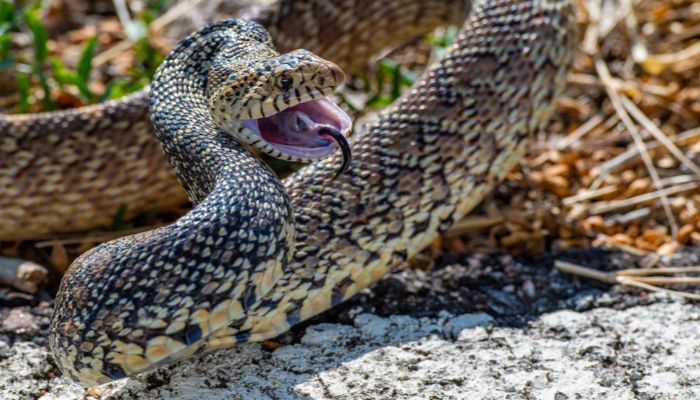
While the science behind denim’s protective properties is intriguing, it’s essential to ground ourselves in the reality of snake bites. After all, understanding the nuances of these encounters can be the difference between a close call and a life-threatening situation.
Amount of Venom Delivered
Differences between small and large snakes:
It’s a common assumption that the size of a snake directly correlates with the amount of venom it can deliver. And to an extent, this is true.
Larger snakes, with their bigger venom glands and longer fangs, can deliver a more substantial amount of venom in a single bite compared to their smaller counterparts.
However, the concentration of venom, its potency, and the snake’s age can also influence the severity of a bite.
The potential fatal amount even with denim protection:
While our trusty jeans might reduce the venom’s impact, it’s crucial to remember that they don’t offer complete immunity.
Especially with larger snakes, even a reduced venom dose can be lethal. For instance, a bite from a large rattlesnake, even through denim, can still deliver a venom amount that can cause severe complications or even death if not treated promptly.
It’s a stark reminder that while denim can be a protective layer, it’s not a guaranteed lifesaver.
Debunking Myths
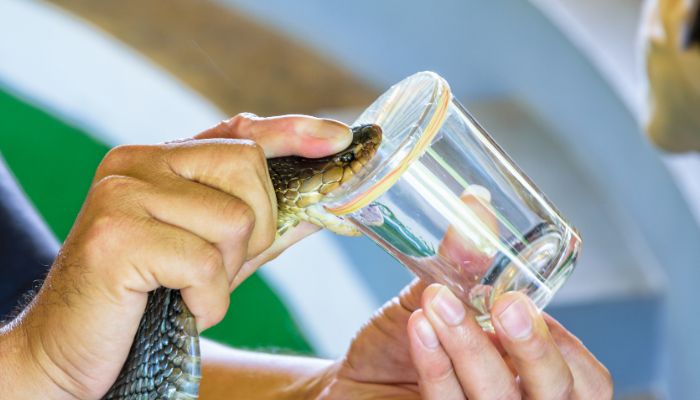
The misconception that “small snakes are more dangerous”:
One of the most pervasive myths in the world of snakes is the belief that smaller snakes are inherently more dangerous than larger ones.
This misconception stems from the idea that younger snakes, unsure of their venom’s potency, might release all their venom in a single bite. However, this notion is largely unfounded.
While younger snakes might be more unpredictable, it doesn’t necessarily mean they deliver more venom or that their venom is more potent.
Real data on venom loads and the influence of denim:
Returning to the earlier experiment with the southern Pacific rattlesnakes, the data paints a clear picture. Larger snakes, even when biting through denim, delivered a significantly higher venom load compared to smaller snakes.
In the study, larger snakes delivered up to 41 times the venom load of the smaller snakes. When denim came into play, this load was reduced, but it was still 26 times higher than that of the smaller snakes.
This data not only debunks the myth about small snakes but also emphasizes the importance of understanding the real risks associated with snake bites.
In conclusion, while the world of snake bites is rife with myths and misconceptions, it’s essential to base our understanding on science and real-life data.
Denim, with its potential protective properties, can be a valuable ally in snake-prone areas. However, it’s always best to prioritize safety, awareness, and immediate medical attention in the event of a snake bite.
After all, when it comes to venomous encounters, it’s always better to be safe than sorry.
Practical Implications

As we delve deeper into the relationship between denim and snake bites, it’s essential to consider the practical implications of this knowledge.
How does this information translate to real-world scenarios, and what precautions should one take?
The Benefits of Wearing Denim
Reduction in venom received during defensive strikes:
One of the most significant advantages of donning a pair of jeans in snake-prone areas is the potential reduction in venom during a bite.
As we’ve seen from the studies, denim can significantly reduce the amount of venom delivered, especially during quick defensive strikes. This reduction can be the difference between a mild reaction and a severe envenomation.
Situations where denim can be particularly useful:
Imagine you’re on a camping trip in a region known for its snake population. Wearing jeans can offer an added layer of protection during activities like setting up tents, gathering firewood, or even casual walks around the campsite.
Similarly, for hikers traversing trails in snake habitats, jeans can be a safer clothing choice. Even in urban settings, where one might encounter snakes in gardens or parks, wearing denim can provide peace of mind.
Limitations and Cautions
Denim’s inability to completely prevent envenomation:
While jeans offer a protective barrier, it’s crucial to understand their limitations. Denim is not an impenetrable shield. A snake’s fangs, especially those of larger species, can still penetrate the fabric and deliver venom.
The reduction in venom, though significant, doesn’t equate to zero risk. A bite through denim can still be harmful and requires immediate attention.
The importance of seeking medical attention regardless of clothing:
Let’s consider a real-life scenario. John, an avid birdwatcher, was exploring a forested area wearing his sturdy jeans. He accidentally stepped close to a hidden snake, which defensively struck his leg.
Though he felt the bite was mild due to his jeans, he wisely decided not to take any chances and sought medical attention immediately. This decision potentially saved him from severe complications.
John’s story serves as a reminder that regardless of what you’re wearing, if bitten, it’s imperative to seek medical help. Time is of the essence, and every minute counts.
In wrapping up this section, the practical implications of wearing denim in snake-prone areas are clear. Jeans can offer a valuable layer of protection, reducing the risk associated with snake bites.
However, it’s equally important to recognize their limitations and always prioritize safety. Whether you’re wearing shorts, jeans, or any other attire, the golden rule remains the same: if bitten, seek medical attention without delay.
Snake Bites Around the World
Snake encounters are not limited to one region or continent; they’re a global phenomenon. Different parts of the world have their unique snake species, each with its distinct behavior, habitat, and venom potency.

Let’s take a brief tour around the globe and delve into snake bite scenarios in various regions.
Snake Bites in Australia
Australia is home to some of the world’s most venomous snakes. From the deadly inland taipan to the eastern brown snake, the continent is no stranger to venomous encounters.
But here’s an interesting fact: not all snake bites in Australia result in venom entering the body. In fact, a significant number of bites are “dry bites,” where the snake strikes but doesn’t release venom.
However, this doesn’t mean one can be complacent. Even if there’s a suspicion of a dry bite, it’s crucial to treat every snake bite as a potential medical emergency, given the potency of venom some Australian snakes possess.
Venomous Snake Encounters in Texas
The vast state of Texas, with its diverse landscapes, is home to various snake species, including the western diamondback rattlesnake and the copperhead.
Encounters with these venomous reptiles are not uncommon, especially in rural and semi-arid regions. The key takeaway from Texan snake encounters is the absolute importance of immediate treatment.
Given the rapid onset of symptoms and the potential for severe complications, time is of the essence. Locals often emphasize the need to stay calm, immobilize the bitten limb, and seek medical attention immediately, even if the bite seems minor.
Snake Bites on Remote Trails
For the adventurous souls who tread remote trails, snake encounters are a real risk. Whether it’s the high-altitude paths of the Himalayas or the dense forests of the Amazon, snakes are a part of the natural ecosystem.
On remote trails, the challenge is twofold: not only is there a risk of snake bites, but accessing medical help can be a daunting task. It’s a stark reminder for hikers and trekkers to be prepared.
Carrying a basic first aid kit, understanding the local snake species, and having an emergency evacuation plan are essential. After all, in the wilderness, it’s always better to be over-prepared than under-prepared.
Conclusion
As we wrap up our exploration into the intriguing relationship between denim and snake bites, a few key takeaways emerge.
The potential of denim as a protective measure:
Denim, with its rugged and durable nature, has shown promise as a protective barrier against snake bites. Studies have highlighted its ability to reduce venom delivery, especially during rapid defensive strikes.
While it’s not a foolproof shield, it certainly offers an added layer of protection, making it a valuable ally in snake-prone areas.
The importance of awareness and preparedness:
While clothing choices, like wearing jeans, can play a role in reducing the risk of severe envenomation, nothing beats awareness and preparedness.
Understanding the local snake species, recognizing their habitats, and knowing what to do in the event of a bite are crucial. It’s always better to prevent an encounter than to deal with its aftermath.
Final thoughts on the relationship between denim and snake bites:
The world of snakes is as fascinating as it is perilous. As we’ve seen, denim can be a valuable tool in our arsenal against snake bites. However, it’s just one piece of the puzzle.
A holistic approach, combining the right clothing choices with awareness and prompt medical intervention, is the best strategy.
After all, in the dance between humans and snakes, it’s always best to tread with respect and caution.
FAQ
Is denim snakeproof?
While denim can reduce the amount of venom delivered during a snake bite, it’s not entirely snake-proof. It offers a protective barrier, but it’s not a guarantee against envenomation.
What material can stop a snake bite?
No material can guarantee complete protection against snake bites. However, materials like denim, thick leather, and specially designed snake gaiters can offer significant resistance against fangs.
Can socks prevent snake bites?
Socks, especially thicker ones, can provide an added layer of protection against snake bites. However, they’re not a foolproof measure. It’s always best to combine them with other protective clothing, like boots or gaiters, in snake-prone areas.
What should I wear to prevent snake bites?
In snake-prone areas, it’s advisable to wear closed shoes or boots, long pants (preferably denim or a thick material), and snake gaiters if venturing into dense vegetation. Loose-fitting clothes can also reduce the chance of fangs reaching the skin.
Can snakes bite through leather boots?
Leather boots, especially those designed for outdoor activities, offer a good degree of protection against snake bites. However, it’s essential to note that while thick leather can resist many snake fangs, it’s not impenetrable. Some larger snakes with longer fangs might still be able to bite through, so always exercise caution.

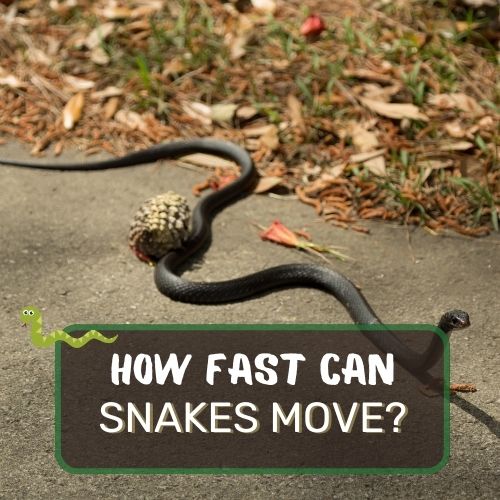
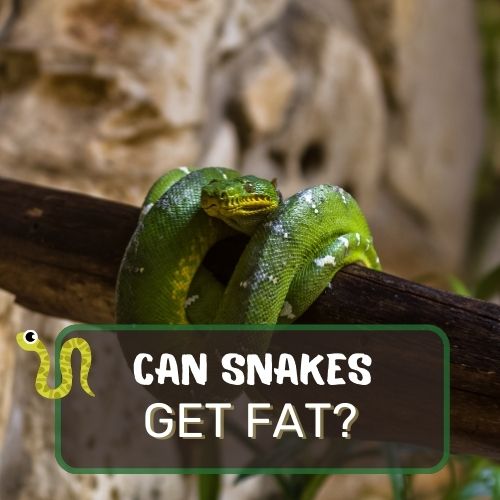

0 Comments